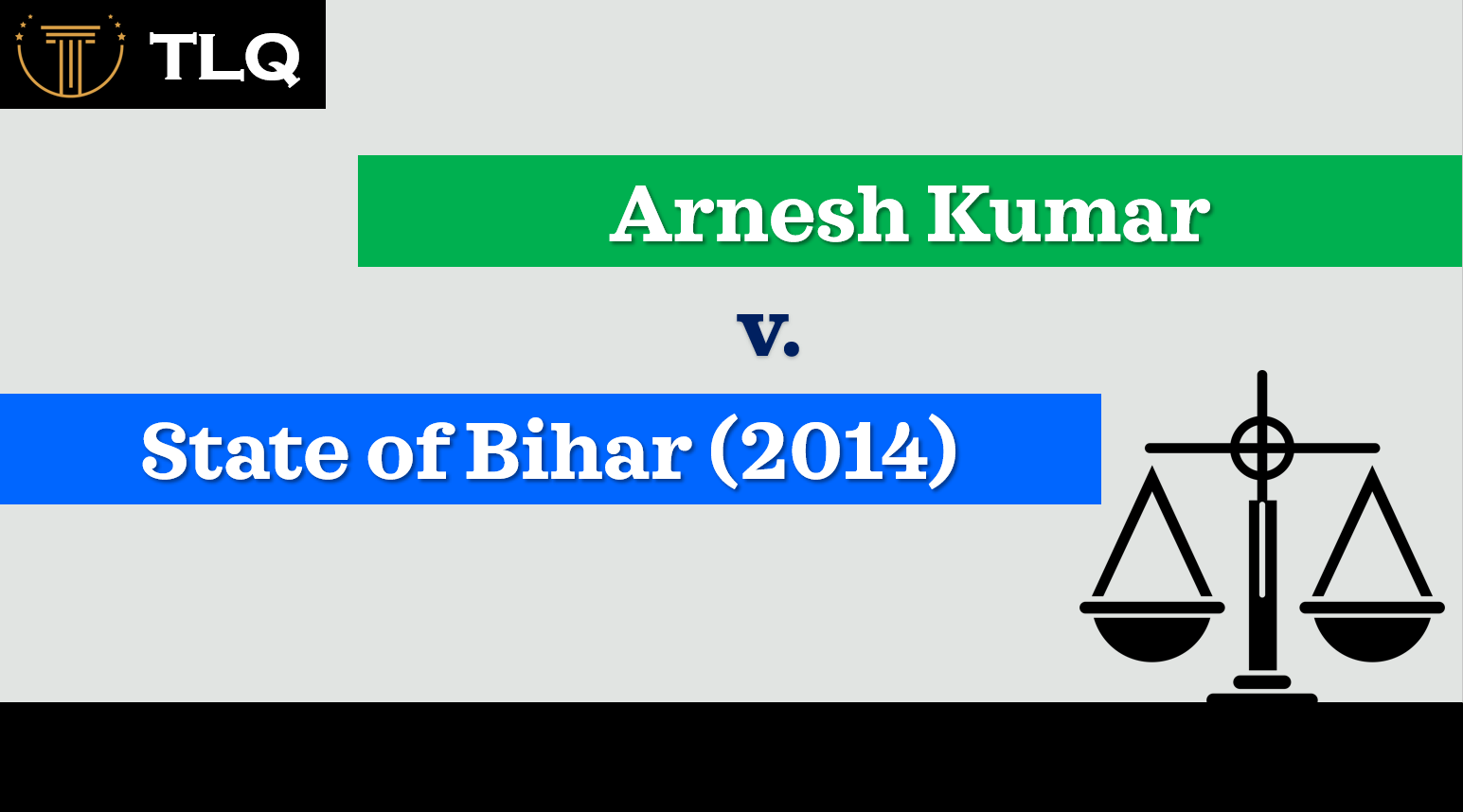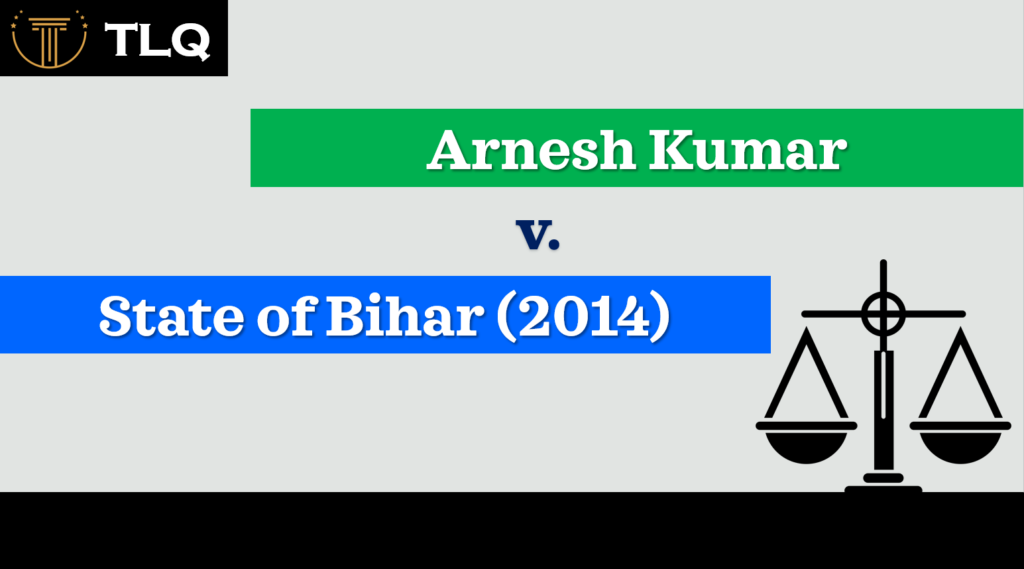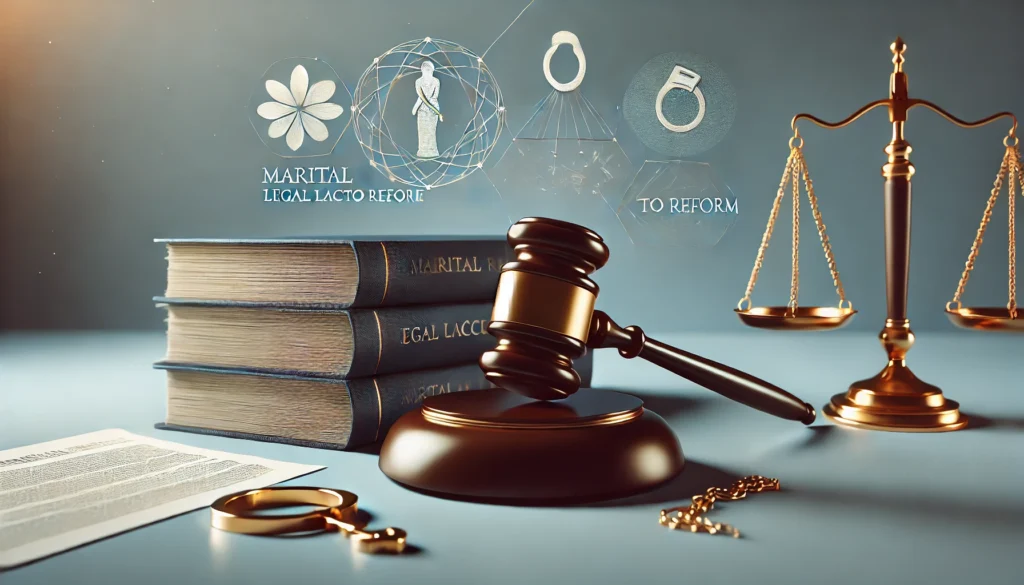Published On: 22nd June, 2024

Case Name- Arnesh Kumar vs. State of Bihar (2014) 8 Scc 273
Court Name- The Supreme Court of India at Delhi
Judges- Justice Chandramauli Kr. Prasad and Justice Pinaki Chandra Ghose
Petitioner Name- Arnesh Kumar
Respondent Name- State of Bihar
Date of Judgment- 02nd July 2014
INTRODUCTION
Arnesh Kumar vs. State of Bihar is a landmark ruling by the Supreme Court, which states that arrest should not be common, especially when the offence is non-bailable. It is the duty of the police to follow proper directions that are issued by the Supreme Court and follow proper procedure and not arrest anyone merely upon an allegation as it not only impact the rights of the individual but also their reputation.
In this landmark case, the Supreme Court adjudged upon the powers of the police to arrest any person without a warrant against a complaint under section 498-A of the IPC. This case addresses the misuse of this provision, which pertains to the cruelty against a married woman by her husband or relatives.
FACTS OF THE CASE
Ramesh Kumar (the petitioner) and Shweta Kiran (the respondent) got married on 1st July 2007. Shweta alleged her mother-in-law and father-in-law, of dowry of a Maruti car, an AC, a television set, Rs 8 lac cash, and other things, after which Arnesh Kumar was arrested under the provision of Section 4 of the Dowry Prohibition Act, 1961. She also stated when she told of it her husband, Arnesh, he supported his family and threatened her to marry another woman if the demand wasn’t fulfilled. She also stated that when the demand for dowry was not fulfilled, she was forced to leave the house.
The accused, Arnesh denied all the allegations made by the respondent (his wife). He applied for anticipatory bail which was earlier rejected by the Session Court and then the High Court.
As his attempt to secure the anticipatory bail failed, he by way of Special Leave Petition appealed to the Supreme Court as Arnesh Kumar vs. State of Bihar.
ISSUES
The anticipatory bail was rejected by the High Court, which was the only issue involved in this case. The case of Arnesh Kumar vs. the State of Bihar revolved around the following issues-
- Can the appellant apply for the anticipatory bill?
- Should police arrest anyone based on a complaint if a person is suspected of a serious offence? And if yes, then what guidelines should be followed during arrest?
- What actions can be taken if a woman misuses section 498-A of the IPC, which deals with martial cruelty?
- What are the rights of a person before and after arrest?
- What are the remedies for misuse of section 498-A of IPC by women?
LEGAL PROVISIONS ADDRESSED
Following are the provisions that were addressed in the case of Arnesh Kumar vs. State of Bihar-
- Section 498-A of the Indian Penal Code, 1860– Whoever, being a husband or the relative of the husband of a woman, subjects such woman to cruelty shall be punished with imprisonment for a term which may extend to three years and shall also be liable to fine.
- Section 4 of the Dowry Prohibition Act, 1961– If any person demands, directly or indirectly, from the parents or other relatives or guardian of a bride or bridegroom, as the case may be, any dowry, she shall be punishable with imprisonment for a term which shall not be less than six months, but which may extend to two years and with fine which may extend to ten thousand rupees. Provided that the court may, for adequate and special reasons to be mentioned in the judgment, impose a sentence of imprisonment for a term of less than six months.
- Sections 41, 41A, 57, 167, 438 of the Criminal Procedure Code, 1973–
- Section 41- It lays the conditions for when police may arrest without a warrant. The rule otherwise requires police to obtain an order from a Magistrate along with a warrant authorizing the arrest of a person.
- Section 41A- It outlines the procedure to be followed by the police when arresting a person without a warrant or order.
- Section 57- No officer shall detain a person arrested in custody without a warrant for a longer period than under all the circumstances of the case is reasonable, and such period shall not, in the absence of a special order of a magistrate under section 167, exceed twenty-four hours exclusive of the time necessary for the journey from the place of arrest to the Magistrate’s court.
- Section 167- Procedure when investigation cannot be completed in twenty-four hours.
- Section 438- Talks about the direction for granting bail to the person apprehending arrest.
- Article 22 (2) of the Constitution of India– Every person who is arrested and detained in custody shall be produced before the nearest magistrate within a period of twenty-four hours of such arrest excluding the time necessary for the journey from the place of arrest to the court of the magistrate and no such person shall be detained in custody beyond the said period without the authority of a magistrate.
JUDGMENT
The Supreme Court responded to a Special Leave Petition filed by Arnesh Kumar on 2nd July 2014. In the case of Arnesh Kumar vs. State of Bihar, there was a two-judge panel of the Supreme Court that examined the application of section 41(1)(A) of the Criminal Procedure Code, which outlines certain procedures before making an arrest.
The court in this case observed that section 498A had turned into a tool for wives to fulfill their demands needs, and greed, resulting in the arrest of innocent people without any evidence mainly because the law is non bailable. The Supreme Court acknowledged that there are some women who were misusing the law made for their protection, in this case, the anti-dowry law i.e. section 498A to harass their husbands and in-laws. As a result, the court restricted the police from making any arrests solely based on complaints.
The Court, in this case, directed the police to adhere to section 41 of CrPC 1973 which provides a 9-point checklist to determine the necessity of arrest. In addition to that, the court stated that the Magistrate must decide whether a detained/arrested person should be kept in further custody. The aim of this decision was to maintain a balance between preventing misuse of the law and protecting the rights of the accused.
REACTION
Whereas the decision was welcomed as a landmark judgment to support the rights of the innocent person, it also received criticism from feminists as they felt this decision would only weaken the negotiating power of women.
MANDATORY GUIDELINES/DIRECTIONS
The Supreme Court in Para 13 of the judgment issued certain directions in order to prevent unnecessary and unreasonable arrests by police and unwarranted detentions by the Magistrate, provided the following guidelines/directions-
- State Government must instruct the police officers authorized under them not to arrest someone on the basis of sole complaint when a case is registered under section 498-A of the Indian Penal Code. The arrest should only be made when the situation aligns with the criteria outlined in section 41 of the Criminal Procedure Code.
- All police should consider 9-point checklist mentioned in section 41(1) (b) (ii).
- The police should submit the checklist along with the reasons or evidence supporting the arrest when producing the accused before the magistrate.
- The magistrate should rely on the report and documents provided by police when authorizing further detention.
- The magistrate should be informed within two weeks of the decision not to arrest an accused person from the initiation of the case. The Superintendent of Police can extend this timeframe.
- If police failed to follow such directions of the Court, they could be held in contempt of the court by the appropriate High Court.
- Judicial magistrates may face departmental proceedings if they authorize detention without recording reasons.
- The notice of appearance in terms of section 41A of the Criminal Proceeding Code be served upon the accused within two weeks from the date of institution of the case, which may be extended by the Superintendent of Police.
AFTERMATH
In 2014, it was reported that due to the lack of communication with police, the Guidelines provided by the Supreme Court were not followed.
In May 2021, the amicus curiae, which is an impartial adviser to the court, raised their concern that the Madhya Pradesh Police were not following the Arnesh Kumar Guidelines. The Madhya Pradesh High Court then ordered the Director General of Police to issue directions/guidelines to police to ensure that they follow them. The individuals who had been arrested without following the Guidelines were allowed to seek regular bail for the violation of the guidelines. The court also urged the State Judicial Academy to spread awareness among the police officers and judicial magistrates about the guidelines.
In November 2021, the Telangana High Court granted the petitioner the right to initiate legal proceedings against the police if they violated the procedure provided in section 41A of the Criminal Procedure Code and the Arnesh Kumar Guidelines.
In August 2022, the Prayagraj High Court held a police officer guilty of contempt of the court for disregarding the Guidelines. The police officer was sentenced to imprisonment for 14 days by the court.
CONCLUSION
This landmark judgment of the case of Arnesh Kumar vs. State of Bihar headed by the bench of Justice Prasad and Justice Ghose has carved out the issue regarding the misuse of section 498A of IPC where the court gave directions to the state government and police on how to deal with arrest when a complaint is registered under section 498A of the IPC and also granted bail to the accused for whose arrest the guidelines were not followed.
The Supreme Court discussed the core issue of criminal jurisprudence and enforcement agencies’ power of arrest. The Arnesh Kumar Guidelines issued by the Supreme Court made it easy to determine the conditions or necessity required for arresting any individual upon mere complaints or allegations without any reasonable evidence.
REFERENCE(S):
- Legal Service India E-Journal.
- Law Bhoomi Case Briefs
- Wikipedia
- Arnesh Kumar vs. State of Bihar AIR 2014 SC 2756





